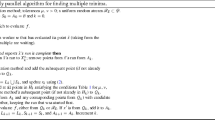Abstract
We analyze the convergence of quasi-Newton methods in exact and finite precision arithmetic. In particular, we derive an upper bound for the stagnation level and we show that any sufficiently exact quasi-Newton method will converge quadratically until stagnation. In the absence of sufficient accuracy, we are likely to retain rapid linear convergence. We confirm our analysis by computing square roots and solving bond constraint equations in the context of molecular dynamics. We briefly discuss implications for parallel solvers.
P. García-Risueño—Independent scholar.
Access this chapter
Tax calculation will be finalised at checkout
Purchases are for personal use only
Similar content being viewed by others
References
Berendsen, H., van der Spoel, D., van Drunen, R.: GROMACS: a message-passing parallel molecular dynamics implementation. CPC 91(1), 43–56 (1995)
Dembo, R.S., Eisenstat, S.C., Steihaug, T.: Inexact Newton methods. SIAM J. Numer. Anal. 19(2), 400–408 (1982)
Dennis, J.E., More, J.J.: Quasi-Newton methods, motivation and theory. SIAM Rev. 19(1), 46–89 (1977)
Forsgren, A.: A sufficiently exact inexact Newton step based on reusing matrix information. TRITA-MAT OS7, Department of Mathematics, KTH, Stockholm, Sweden (2009)
Kelley, C.T.: Iterative Methods for Linear and Nonlinear Equations. No. 16 in Frontiers in Applied Mathematics. SIAM, Philadelphia (1995)
Lemkul, J.A.: GROMACS Tutorial Lysozyme in Water. https://www.mdtutorials.com/gmx/lysozyme/index.html
Mysovskii, I.P.: On the convergence of Newton’s method. Trudy Mat. Inst. Steklova 28, 145–147 (1949). (In Russian)
Ortega, J.M., Rheinboldt, W.C.: Iterative Solution of Nonlinear Equations in Several Variables. Computer Science and Applied Mathematics, Academic Press, New York (1970)
RSCB: Protein Data Bank. https://www.rcsb.org/structure/1AKI
Ryckaert, J.P., Ciccotti, G., Berendsen, H.J.: Numerical integration of the Cartesian equations of motion of a system with constraints: molecular dynamics of n-alkanes. J. Comput. Phys. 23(3), 327–341 (1977)
Tisseur, F.: Newton’s method in floating point arithmetic and iterative refinement of generalized eigenvalue problems. SIAM J. Matrix Anal. Appl. 22(4), 1038–1057 (2001)
Acknowledgments
Prof. I. Argyros commented on an early draft of this paper and provided the reference to the work of I. P. Mysovskii. The first author is supported by eSSENCE, a collaborative e-Science programme funded by the Swedish Research Council within the framework of the strategic research areas designated by the Swedish Government. This work has been partially supported by the Spanish Ministry of Science and Innovation (contract PID2019-107255GB-C21/AEI/10.13039/501100011033), by the Generalitat de Catalunya (contract 2017-SGR-1328), and by Lenovo-BSC Contract-Framework Contract (2020).
Author information
Authors and Affiliations
Corresponding author
Editor information
Editors and Affiliations
Rights and permissions
Copyright information
© 2023 The Author(s), under exclusive license to Springer Nature Switzerland AG
About this paper
Cite this paper
Kjelgaard Mikkelsen, C.C., López-Villellas, L., García-Risueño, P. (2023). How Accurate Does Newton Have to Be?. In: Wyrzykowski, R., Dongarra, J., Deelman, E., Karczewski, K. (eds) Parallel Processing and Applied Mathematics. PPAM 2022. Lecture Notes in Computer Science, vol 13826. Springer, Cham. https://doi.org/10.1007/978-3-031-30442-2_1
Download citation
DOI: https://doi.org/10.1007/978-3-031-30442-2_1
Published:
Publisher Name: Springer, Cham
Print ISBN: 978-3-031-30441-5
Online ISBN: 978-3-031-30442-2
eBook Packages: Computer ScienceComputer Science (R0)




